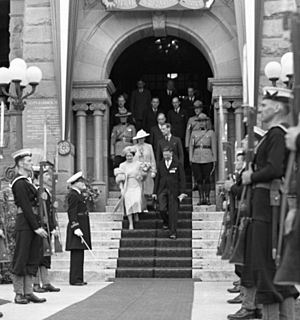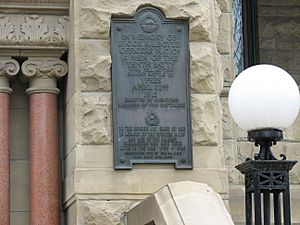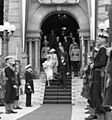Calgary City Hall facts for kids
Quick facts for kids Calgary City Hall |
|
|---|---|
 |
|
| General information | |
| Type | Town hall |
| Architectural style | Romanesque Revival |
| Address | 716 Macleod Trail SE Calgary, Alberta T2G 5E6 |
| Coordinates | 51°02′46″N 114°03′27″W / 51.0460°N 114.0574°W |
| Construction started | 1907 |
| Completed | June 26, 1911 |
| Cost | $300,000 in 1911 |
| Client | City of Calgary |
| Owner | City of Calgary |
| Technical details | |
| Floor count | 4 |
| Design and construction | |
| Architect | William M. Dodd |
| Official name: Calgary City Hall National Historic Site of Canada | |
| Designated: | 1984-11-23 |
| Official name: Calgary City Hall | |
| Designated: | 1978-10-18 |
Calgary City Hall, also known as Old City Hall or Historic City Hall, is a very important building in Calgary, Alberta, Canada. It's where the city's government, called the Calgary City Council, meets and works. This historic building was finished in 1911. It holds the offices for the Mayor of Calgary, the fourteen City Councillors, and the municipal Clerk.
Calgary City Hall used to be the main place for the city council and many city offices until 1985. That's when the Calgary Municipal Building was built right next door. Today, the Municipal Building is where about 2,000 city workers have their offices.
Calgary City Hall is recognized as a National Historic Site of Canada. It's also a Provincial Historical Resource and a Municipal Historical Resource. This means it's a very special and protected building because of its history and architecture.
Contents
History of Calgary City Hall
Calgary City Hall was built on the same spot where the city's very first town hall stood. The land for the first town hall was given by a private citizen in 1885. This was just one year after Calgary officially became a municipality (a self-governing city). The first town hall was made of wood and was torn down after only a few years.
In the early 1900s, Calgary was growing fast. It became clear that the city needed a bigger, new place for its government. There was a big discussion about where this new building should be. In 1904, the City Council found a good spot at 7th Avenue and 1st Street S.E. It cost $20,000.
The plan for the new location was put to a public vote, called a plebiscite. For the plan to pass, two-thirds of the voters had to agree. 156 people voted for it, and 95 voted against it. The plan failed by just 12 votes!
Finally, the city decided to build the new City Hall on the same land as the original one. It was set back a little from the old structure. The city hired an architect named William M. Dodd. He had designed other buildings in Calgary, like Central School and Alexandra School. He also helped with Regina's City Hall. Construction of the new Calgary City Hall began in 1907. However, the project quickly ran into money and design problems.
Building Challenges and Costs
The new City Hall is a four-storey building. It has a strong steel frame that supports its outside walls. These walls are made of Paskapoo Sandstone. This type of sandstone became very popular for building in Calgary after the Calgary Fire of 1886. The stone for City Hall came from the Bone and Oliver Quarry.
Building the City Hall was full of arguments and delays. The costs kept going up. In April 1909, people voted against a plan to get more money for the construction. Because the vote failed, William Dodd stopped paying the main builder, the Alberta Building Company. So, they stopped working on the building.
Soon after, in January 1910, William Dodd was no longer the architect for the project. A local company called Hodgson & Bates took over. Construction started again in Spring 1910 after more money was approved. By the time it was finished in 1911, the project cost about $300,000. This was about twice what they first planned!
A Special Time Capsule
A special copper box was placed inside the building's cornerstone on September 14, 1908. A cornerstone is the first stone laid in a building, often with a ceremony. Calgary's 10th Mayor, Arthur Leslie Cameron, and former mayors George Murdoch and George Clift King placed the box.
Inside the time capsule were many interesting items. These included a copy of the New Testament, official city rules (bylaws), a list of voters, reports from city departments, and medals. There were also copies of the five newspapers that were printed in Calgary at that time.
The time capsule stayed sealed for over 100 years! Mayor Naheed Nenshi opened it in November 2018. This happened during a big restoration project for the building.
Opening Day and Early Use
The much-awaited Calgary City Hall officially opened on June 26, 1911. Robert Borden, a Member of Parliament and Leader of the Opposition, opened the building. He later became the Prime Minister of Canada.
Even though it was a big new building, Calgary was growing so fast that City Hall quickly became too small. By 1913, only two years after it opened, the building was already too small for some city services.
When it first opened, Calgary City Hall was also the main office for the Calgary Police Service from 1911 to 1914. It even had 15 jail cells on the ground floor! The city's court room was also on the ground floor, right next to the police department.
When the building first opened, a cannon was placed near the front entrance. Later, a fountain replaced the cannon. The area around City Hall was also decorated with 210 palm trees. One of these palm trees amazingly survived until 1935!
Remembering Heroes
There is a special plaque at the entrance of Calgary City Hall. It is there to remember Lieutenant-Colonel Russell Lambert Boyle and the 10th Battalion, CEF. Russell Lambert Boyle was a rancher from the Calgary area. He was killed during the Second Battle of Ypres in World War I. He was leading the 10th Battalion, which was made up of soldiers from Calgary and Winnipeg.
What Calgary City Hall Looks Like
Architect William M. Dodd designed Calgary City Hall to show Calgary's importance. He wanted it to look like a strong, important building for Southern Alberta. Dodd was known for his designs, including the old Regina City Hall.
Dodd designed Calgary City Hall in the Richardsonian Romanesque architectural style. This style often uses heavy stone walls and has a balanced look. The building has a tall clock tower with a special clock made by the Seth Thomas Clock Company. You can see strong stone walls, rows of windows set back into the walls, and a main entrance that is also set back. Many windows and entrances have stone arches and special carved stones called keystones above them. Some of these keystones are carved with Calgary's coat-of-arms.
Inside, some cool features include a fancy cast-iron staircase and open areas with skylights, called rotundas.
Why it's a Historic Site

Calgary City Hall is recognized as a very important historical building.
- On October 18, 1978, it was named a Provincial Historical Resource. This means it's important to Alberta's history. Its value comes from Calgary's history as a major city in Southern Alberta. It's also important because it's a grand and significant city building.
- On November 23, 1984, Calgary City Hall was named a National Historic Site of Canada. This means it's important to all of Canada's history. It's special because it's the only city hall built before the 1930s in the prairie cities that is still standing. Its Romanesque Revival style and clock tower also make it stand out.
- On April 17, 1990, the City of Calgary itself named City Hall its first Municipal Historic Resource. This was done under the Historical Resources Act.
What it's Used For Today
Calgary City Hall is still a busy place! It's used as office space for the Mayor, the City Councillors, and the municipal Clerk. The main meeting rooms for Calgary City Council and other city offices are in the Calgary Municipal Building next door.
Keeping it Strong: Restoration Work
People have been talking about the condition and cost of Calgary City Hall since it was first built in 1907. The building has been repaired and updated many times over the years.
- The first big restoration happened in 1962. It cost about CA$2.5 million and fixed both the inside and outside of the building.
- The second restoration was in the late 1990s and cost about CA$9.3 million.
In late 2014, the Calgary City Council approved CA$34.1 million for more repairs and updates to Old Calgary City Hall. You might have seen protective scaffolding (a temporary structure for workers) around the building since 2014. This was put up because pieces of the original sandstone were starting to fall off. The work is so big that the Mayor and City Council members had to move out of the building for up to four years while it was being fixed.
Images for kids
-
During the 1939 Royal Tour of Canada, Queen Elizabeth The Queen Mother is escorted down the stairs of Calgary City Hall by Mayor Andrew Davison. Prime Minister William Lyon Mackenzie King is following behind King George VI




